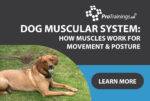How a Dog’s Muscles Work Together for Movement and Posture
A dog’s muscular system functions as a complex network, enabling everything from walking and running to sitting and maintaining balance. Working alongside the skeletal system, muscles generate force and stabilise the body, allowing a dog to move efficiently and react quickly to its surroundings. When your dog sprints after a ball, leaps into the air, or stands calmly by your side, their muscles coordinate to make it all possible.
In a well-functioning muscular system, groups of muscles contract and relax in a seamless pattern. For example, when a dog runs, the muscles of the hindlegs contract powerfully to push the body forward, while the foreleg muscles help absorb impact and maintain balance. Similarly, core muscles along the back and abdomen help stabilise the spine, ensuring the dog’s movement is smooth and controlled.
This interplay between muscle groups is not just crucial for mobility but also for posture. Even when a dog is stationary, certain muscles remain partially contracted to maintain an upright position and ensure proper alignment. The dog’s centre of gravity is supported by this continuous low-level muscle activity, which prevents it from toppling over and keeps the skeleton adequately aligned.
Major Muscle Groups: Neck, Shoulders, Back, Legs
While every muscle in a dog’s body plays a role in movement and stability, certain muscle groups are particularly crucial. These groups work together harmoniously, each performing a specialised function contributing to the dog’s overall strength and agility.
- Neck Muscles:
The neck muscles support the head, allowing the dog to raise or lower it, turn from side to side, and even tilt in different directions. This is especially important for dogs when tracking a scent, scanning their surroundings, or interacting with other animals. Neck muscles also play a role in stabilising the head when a dog is running or jumping, helping maintain balance and focus. - Shoulder Muscles:
The shoulders are a key pivot point for the forelegs. Strong shoulder muscles like the deltozids, trapezius, and supraspinatus allow a wide range of movement and provide stability during weight-bearing activities. When a dog sprints, jumps, or lands after a leap, these muscles absorb shock and help keep the front end steady. In addition, the shoulder muscles enable a dog to extend or flex its front legs, giving it the reach and flexibility needed for various activities. - Back and Core Muscles:
The muscles along the dog’s back, including the longissimus and latissimus dorsi, play a central role in maintaining posture and facilitating movement. They help stabilise the spine, ensuring the dog’s body remains well-aligned and can withstand the forces generated during motion. Core muscles in the abdomen complement these back muscles by providing additional support to the spinal column. The back and core muscles act as the body’s foundation, allowing for smooth transitions between walking, running, and resting positions. - Leg Muscles:
The legs, both front and back, contain powerful muscle groups that drive movement. In the hindlegs, muscles like the quadriceps, hamstrings, and gluteals generate the push needed to propel the dog forward or upward. These muscles also play a role in maintaining balance and stability during sudden stops or sharp turns. In the forelegs, muscles such as the biceps brachii and triceps brachii provide the strength and flexibility needed for impact absorption, pulling motions, and stabilisation. Overall, the leg muscles give a dog the agility, speed, and endurance to perform a wide range of physical activities.
Signs of Muscle Strain or Injury and What to Do
Even the fittest dogs can experience muscle strains, sprains, or other injuries. These issues can occur during vigorous play, after an intense workout, or due to sudden twisting movements. Pet owners must recognise the signs of muscle-related problems and take appropriate steps to address them.
- Common Signs of Muscle Strain or Injury:
- Limping or favouring one limb
- Stiffness, especially after exercise or rest
- Reluctance to jump, run, or climb stairs
- Swelling or tenderness in a specific area
- Decreased activity levels or lethargy
- Whining, growling, or other vocalisations when the affected area is touched
- What to Do if You Suspect a Muscle Problem:
- Rest and Restricted Activity:
The first step in addressing muscle strain is to limit the dog’s activity. Encourage them to rest and avoid strenuous exercises for a few days. This gives the muscles time to heal and reduces the risk of further injury. - Cold and Warm Compresses:
Applying a cold compress to the affected area in the first 24 to 48 hours can help reduce swelling and ease discomfort. After the initial period, a warm compress may improve circulation and promote healing. Always use a barrier, like a cloth, between the compress and your dog’s skin, and monitor their reaction to ensure they’re comfortable. - Gentle Massage and Stretching:
Once the initial pain subsides, gentle massage can help relax tight muscles and improve blood flow to the area. Mild stretching exercises (if your vet approves) may also prevent stiffness and restore mobility. However, avoid overdoing it, as forcing movement can worsen the injury. - Consulting a Veterinarian:
If the symptoms persist, worsen, or are accompanied by other concerning signs (such as severe swelling, inability to bear weight, or signs of distress), it’s essential to consult your veterinarian. They can diagnose the problem more accurately and may recommend additional treatments like anti-inflammatory medications, physical therapy, or, in severe cases, imaging tests to rule out more serious conditions.
- Rest and Restricted Activity:
Understanding how a dog’s muscles work and recognising the signs of strain or injury can help ensure your pet remains active, comfortable and healthy. Combining knowledge of the major muscle groups with early intervention when problems arise allows you to keep your dog moving happily and pain-free.

